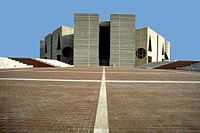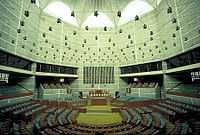Jatiyo Sangsad Bhaban
| Jatiyo Sangsad Bhaban জাতীয় সংসদ ভবন | |
|---|---|
.jpg) | |
| General information | |
| Type | National Assembly Building |
| Architectural style | Modern, Monumental |
| Location | Dhaka, Bangladesh |
| Construction started | 1961 |
| Completed | 1982 |
| Cost | US$32 million[1] |
| Technical details | |
| Structural system | Reinforced concrete, Brickwork |
| Design and construction | |
| Architect |
Louis Kahn Muzharul Islam (co architect) |
Jatiyo Sangsad Bhaban or National Parliament House, (Bengali: জাতীয় সংসদ ভবন Jatiyô Sôngsod Bhôbôn) is the house of the Parliament of Bangladesh, located at Sher-e-Bangla Nagar in the Bangladeshi capital of Dhaka. Designed by architect Louis Kahn, the complex, which accommodates all Bangladesh's seven parliaments, is one of the largest legislative complexes in the world, comprising 200 acres (800,000 m²)[1]
The building was featured prominently in the 2003 film My Architect, detailing the career and familial legacy of its architect, Louis Kahn. Robert McCarter, author of Louis I. Kahn, described the National Parliament of Bangladesh as one of the twentieth century's most significant buildings.[2]
History

There have been nine national elections in Bangladesh. The first and second Parliaments used the Old Shangshad Bhaban, which currently serves as the Prime Minister's Office.
Jatiyo Sangshad was designed by Louis Kahn. Initially, the government had appointed Muzharul Islam as the center's architect, but Islam deferred, instead recommending bringing in the world's top architects for the project. He initially attempted to bring Alvar Aalto and Le Corbusier, who were both were unavailable at the time. Islam then enlisted his former teacher at Yale, Louis Kahn.
The design of the capital complex was developed taking into account the aesthetic heritage of Bengal, particularly including the Ganges delta.
Construction began in 1961 by President Ayub Khan, the then president of Pakistan as a permanent building for the federal legislature of both West Pakistan and East Pakistan and was completed after the country's war of independence and several decades — on 28 January, 1982. The complex opened the following month on 15 February for the eighth (and last) session of the second parliament of Bangladesh and has since operated as the sole complex for the National Assembly.
Gallery
-

-

-
View at sunrise
-
-
-
-
-

Assembly Hall
-

-

The parliament building at night
History of use by Parliament
Seven Parliaments have used the Jatiyo Sangsad Bhaban as the assembly building:
- Second Parliament: 2 years 11 months (2 April 1979 - 24 March 1982)
- Third Parliament: 1 year 5 months (10 July 1986 - 6 December 1987)
- Fourth Parliament: 2 years 7 months (15 April 1988 - 6 December 1990)
- Fifth Parliament: 4 years 8 months (5 April 1991 - 24 November 1995)
- Sixth Parliament: 12 days (19 March 1996 - 30 March 1996)
- Seventh Parliament: 5 years (14 July 1996 - 13 July 2001)
- Eighth Parliament: 5 years (28 October 2001 - 27 October 2006)
- Nine Parliament :5 years
Architecture and design
Louis Kahn designed the entire Jatiyo Sangsad complex, which includes lawns, lake and residences for the Members of the Parliament (MPs).The architect’s key design philosophy was to represent Bangladeshi culture and heritage, while at the same time optimizing the use of space. The exterior of the building is striking in its simplicity, with huge walls deeply recessed by porticoes and large openings of regular geometric shapes. The main building, which is at the center of the complex, is divided into three parts – the Main Plaza, South Plaza and Presidential Plaza. An artificial lake surrounds three sides of the main building of Jatiyo Sangsad Bhaban, extending to the Members of Parliament hostel complex. This skillful use of water to portray the riverine beauty of Bangladesh adds to the aesthetic value of the site.[3]
Location and basic layout
The enclave, situated in Sher-e-Bangla Nagar, is bounded by four major streets:
- Lake Road to the North;
- Rokeya Sarani to the East;
- Manik Mia Avenue to the South; and
- Mirpur Road to the West.
coordinates: 23.7624683 90.3784485 [4]
The main building (the Bhaban) is divided into three parts:
- The Main Plaza: 823,000 square feet (76,000 m²)
- South Plaza: 223,000 square feet (21,000 m²)
- Presidential Plaza: 65,000 square feet (6,000 m²)
The main building is at the center of the complex. The outer parts of the complex include the MP hostel. An intricately designed lake surrounds the main building.
Design philosophy
Kahn's key design philosophy optimizes the use of space while representing Bangladeshi heritage and culture. External lines are deeply recessed by porticoes with huge openings of regular geometric shapes on their exterior, shaping the building's overall visual impact.
In the architect Louis Kahn's own words:
In the assembly I have introduced a light-giving element to the interior of the plan. If you see a series of columns you can say that the choice of columns is a choice in light. The columns as solids frame the spaces of light. Now think of it just in reverse and think that the columns are hollow and much bigger and that their walls can themselves give light, then the voids are rooms, and the column is the maker of light and can take on complex shapes and be the supporter of spaces and give light to spaces. I am working to develop the element to such an extent that it becomes a poetic entity which has its own beauty outside of its place in the composition. In this way it becomes analogous to the solid column I mentioned above as a giver of light.
It was not belief, not design, not pattern, but the essence from which an institution could emerge...[5]
The lake on three sides of the Bhaban, extending up to the Members' hostel adds to site's aesthetics and also portrays the riverine beauty of Bangladesh.
The assembly building received the Aga Khan Award for Architecture in 1989.
The Bhaban (Main Building) design
The Bhaban consists of nine individual blocks: the eight peripheral blocks rise to a height of 110' while the central octagonal block rises to a height of 155'. All nine blocks include different groups of functional spaces and have different levels, inter-linked horizontally and vertically by corridors, lifts, stairs, light courts, and circular areas. The entire structure is designed to blend into one single, non-differentiable unit, that appears from the exterior to be a single story.
The main committee rooms are located at level two in one of the peripheral blocks. All parliamentary functionaries, including Ministers and chairpersons of some of the Standing Committees, have offices in the Bhaban. The Parliament Secretariat also occupies offices in the same building.
The Main Plaza
The most important part of the Main Plaza is the Parliament Chamber, which can house up to 354 members during sessions. There are also two podiums and two galleries for VIP visitors. The Chamber has a maximum height of 117' with a parabolic shell roof. The roof was designed with a clearance of a single story to let in daylight. Daylight, reflecting from the surrounding walls and octagonal drum, filters into the Parliament Chamber. The efficient and aesthetic use of light was a strong architectural capability of Louis Kahn.
The artificial lighting system has been carefully devised to provide zero obstruction to the entry of daylight. A composite chandelier is suspended from parabolic shell roof. This chandelier in turn consists of a metallic web, spanning the entire chamber, that supports the individual light fixtures.
Upper levels of the block (that contains the Chamber) contain the visitor and press galleries, as well as communication booths, all of which overlook the Parliament Chamber. The block also contains:
- at level one, a library;
- at level three, MPs’ lounges; and
- at the upper level, party rooms.
The South Plaza
The South Plaza faces the Manik Mia Avenue. It gradually rises to a 20' height and serves as a beautiful exterior as well as the main entrance (used by members during sessions) to the Parliament Building. It contains:
- controlling gates;
- a driveway;
- a main mechanical plant room;
- a large car parking space;
- a telephone exchange;
- offices of maintenance engineers;
- equipment stores; and
- an open plaza with steps and ramps leading directly to the main building.
Presidential Plaza
The Presidential Plaza lies to the North and faces the Lake Road. It functions as an intimate plaza for the MPs and other dignitaries. It contains marble steps, a gallery and an open pavement.
- Other information
- Completion date: 1982
- Function: civic
- Construction cost: US$32 million[4]
Tourism and accessibility
Although entrance to the Bhaban, the Main Building, is limited to authorized members of Parliament and staff, the Jatiyo Sangshad complex is open to visitors. On the North of complex, across the Lake Road, is Crescent Lake and Zia Uddan (also called Chondrima Uddan). The two complexes together form a major attraction for tourists in Dhaka. The complexes are popular among joggers and skaters of Dhaka. The official Prime Minister's Residence is on the North West corner of the Mirpur Road and Lake Road crossing and is a five minute walk from the Jatiyo Sangsad Bhaban. The area is one of the higher security zones of Dhaka.
The Complex can be accessed using any of the four roads surrounding it, however, the Manik Mia Avenue and Lake Road are the easiest approaches.
Current developments
During the government term that took office on 28 October 2001, the Government communicated plans to "complete Louis Kahn's plans" by constructing residences for the Speaker and Deputy Speaker. According to some prominent architects, no such plan existed in the original design. Although the construction was started, it was halted and the issue is still unresolved.
Notes
- ↑ 1.0 1.1 http://www.banglapedia.org/httpdocs/HT/N_0080.HTM
- ↑ McCarter, Robert (2005). Louis I. Kahn. London: Phaidon Press. p. 258,270. ISBN 0-7148-4045-9.
- ↑ http://www.bangladesh.com/blog/the-grand-architecture-of-jatiyo-sangsad-bhaban
- ↑ 4.0 4.1 http://www.checkonsite.com/jatiyo-sangsad-bhaban/
- ↑ Source: Louis I. Kahn. from Heinz Ronner, with Sharad Jhaveri and Alessandro Vasella Louis I. Kahn: Complete Works 1935-74. p236, 238.
References
- McCarter, Robert [2004]. Louis I. Kahn. Phaidon Press Ltd, p. 512. ISBN 0-7148-4045-9.
- Wiseman, Carter [2007]. Louis I. Kahn: Beyond Time and Style: A Life in Architecture, New York: W.W. Norton. ISBN 0-393-73165-0.
External links
| Wikimedia Commons has media related to National Assembly of Bangladesh (Jatiyo Sangshad Bhaban). |
- Bangladesh Parliament Legislative Information Centre
- ArchNet Entry Images, articles on the Jatiyo Sangshad Bhaban.
- Seven Wonders of the World, Architecture The Globe and Mail has named it as one of the seven architectural wonders of the world.
| ||||||||
Coordinates: 23°45′45″N 90°22′43″E / 23.7625°N 90.3785°E




